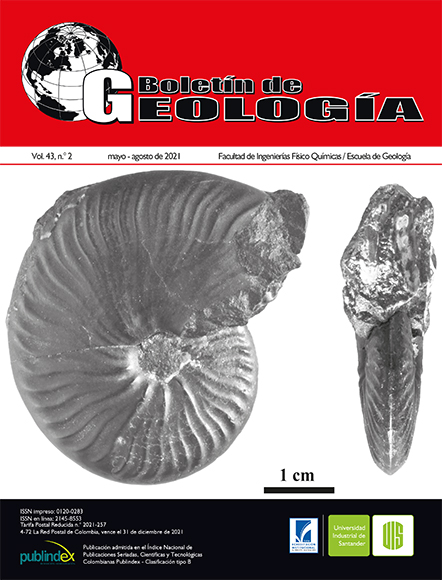Published 2021-05-31
Keywords
- Seismic stratigraphy,
- Seismic attributes,
- Well logs,
- Facies
How to Cite
Altmetrics
Abstract
Seismic stratigraphy becomes a useful tool when it comes to 3D lithology distribution, since it gives the interpreter insights of the facies most likely to be present in a certain sedimentary environment. On the other hand, it is also the main input information while modeling petrophysical properties like water saturation, effective porosity and permeability, which are critical in the process of evaluation of a hydrocarbon reservoir. In this context, techniques such as seismic inversion allows the geoscientists to get 3D models of P-impedance, S-impedance and density, which are used as the main input to estimate the reservoir petrophysical properties just mentioned and additionally useful parameters used as a lithology indicator. This paper proposes a workflow to achieve the goal of integrating seismic stratigraphy, seismic inversion and attributes to get a lithology 3D model. Now, to get a suitable correlation between the facies interpreted using well logs and core data with the elastic properties, rock physic templates (RPT’s) were made where proper elastic modulus was carefully chosen to define probability distribution functions (PDF’s) for each facies defined in the correlation wells. On the other hand, based on a set of stratigraphic surfaces created on a different study, 3D models of P-impedance, S-impedance and density were obtained from seismic inversion so that the RPT’s could be built. For this specific instance, only a set of the elastic properties and seismic attributes offered a suitable correlation with the facies defined in the calibration wells. Moreover, the probability distribution functions (PDF’s) already generated allowed the distribution in 3D and the definition of the ranges in which each facies previously stated varies for the elastic modulus estimated.
Downloads
References
Bahorich, M.; Farmer, S. (1995). 3-D seismic discontinuity for faults and stratigraphic features: the coherence cube. The Leading Edge, 14(10), 1021-1098. https://doi.org/10.1190/1.1437077
Bain, J.S. (1993). Historical overview of exploration of Tertiary plays in the UK North Sea. Geological Society, London, Petroleum Geology Conference series, 4, 5-13. https://doi.org/10.1144/0040005
Brooks, J.; Glennie, K.W. (1987). Petroleum geology of North-West Europe. Graham & Trotman.
Doyen, P.M. (2007). Seismic reservoir characterization: An Earth modelling perspective. EAGE.
Gautier, D.L. (2005). Kimmeridgian shales total petroleum system of the North Sea Graben province. U.S. Geological Survey, Bulletin 2204-C.
Greenberg, M.L.; Castagna, J.P. (1992). Shear-wave velocity estimation in porous rocks: theoretical formulation, preliminary verification and applications. Geophysical Prospecting, 40(2), 195-209. https://doi.org/10.1111/j.1365-2478.1992.tb00371.x
Hancock, J.M.; Scholle, P.A. (1975). Chalk of the North Sea. In: A.W. Woodland (ed.). Petroleum and the continental shelf of North-West Europe (pp. 413-427). vol. 1. John Wiley & Sons.
Illidge, E. (2017). Inversión y atributos sísmicos en la clasificación de Litotipos. Tesis de Maestría, Universidad Industrial de Santander, Bucaramanga, Colombia.
Illidge, E.; Camargo, J.; Pinto, J. (2016). Turbidites characterization from seismic stratigraphy analysis: application to the Netherlands Offshore F3 Block. AAPG/SEG International Conference & Exhibition, Cancun, Mexico.
Lubbe, R.; El Mardi, M. (2015). Rock Physics Guided Quantitative Seismic Inversion. 3rd EAGE Workshop on Rock Physics. Istanbul, Turkey.
Pegrum, R.M.; Spencer, A.M. (1990). Hydrocarbon plays of the northern North Sea. Geological Society, London, Special Publications, 50, 441-470. https://doi.org/10.1144/GSL.SP.1990.050.01.27
Reynolds, T. (1994). Quantitative analysis of submarine fans in the Tertiary of the North Sea Basin. Marine and Petroleum Geology, 11(2), 202-207. https://doi.org/10.1016/0264-8172(94)90096-5
Smaili, M. (2009). 3D seismic-based lithology prediction using impedance inversion and neural networks application: case-study from the Mannville Group in East-Central Alberta, Canada. Master Thesis, McGill University, Montreal, Canada.
Walls, J.; Dvorkin, J.; Carr, M. (2004). Well logs and rock physics in seismic reservoir characterization. Offshore Technology Conference, Houston, USA. https://doi.org/10.4043/16921-MS
Ziegler, P.A. (1990). Geological atlas of Western and Central Europe. 2nd ed. Shell International Petroleum Maatschappij.

